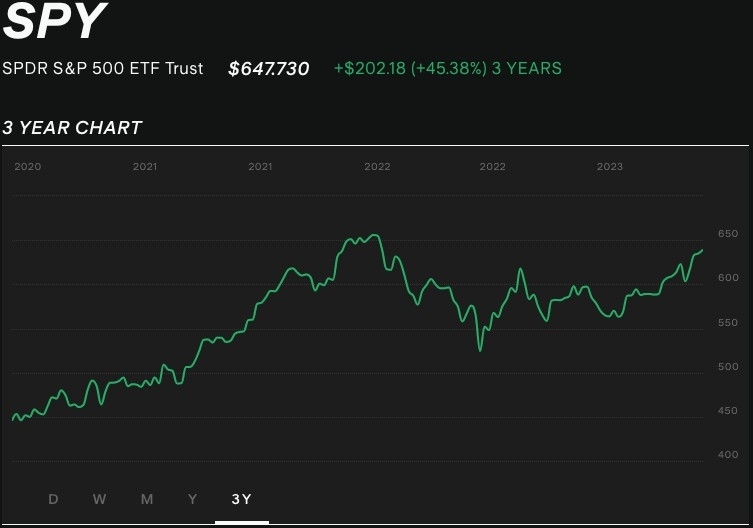
Passive Investing: A complete guide [2023]
Active investors that fail to beat the market might be better off switching to a passive investment strategy. Find out what the pros and cons of being a passive investor are.
What is passive investing?
Passive investing is an investment strategy that aims to generate returns by closely tracking a specific market index or benchmark, rather than actively selecting and managing individual investments. It involves investing in a diversified portfolio of assets with the goal of replicating the performance of the chosen benchmark index.
Passive investing typically involves using index funds or exchange-traded funds (ETFs) that hold a basket of securities mirroring a particular index. These funds are designed to mimic the performance of the underlying index by holding the same stocks or bonds in the same proportions. The objective is to achieve a return that closely matches the overall market performance.
One of the main advantages of passive investing is its simplicity. By investing in a broad-based index fund or ETF, investors can gain exposure to a diversified portfolio of assets without the need for an active approach of stock picking or market timing. This approach often leads to lower costs compared to actively managed funds, as there is no need for extensive research or frequent trading. Passive investing also tends to result in lower portfolio turnover, which can minimise paying capital gains tax on shares.
However, it's important to note that passive investing does not guarantee superior returns or protection against market downturns. Since passive investors essentially aim to replicate the market, they will experience the same fluctuations and risks as the underlying index.
Active management strategies, on the other hand, involve attempting to outperform the market through skilled stock selection and timing, but they often come with higher costs and are subject to the manager's expertise and performance. The choice between a passive and an active investing strategy depends on an investor's goals, risk tolerance, and belief in their ability to beat the market consistently.
Types of passive investing
There are primarily two types of passive investing: index fund investing and exchange-traded fund (ETF) investing.
Index fund investing: Index funds are mutual funds that aim to replicate the performance of a specific market index, such as the ASX 200 or S&P 500. These funds hold a diversified portfolio of securities that closely mirrors the composition of the chosen index. Index fund investors benefit from broad market exposure and the ability to passively participate in the overall market performance.
Exchange-traded fund (ETF) investing: ETFs are similar to index funds, but they trade on stock exchanges like individual stocks. ETFs offer investors the opportunity to buy and sell shares throughout the trading day, providing liquidity and flexibility. Like index funds, ETFs track various indices and aim to replicate their performance. ETFs are available for a wide range of asset classes, including stocks, bonds, commodities, and real estate.
Both index fund investing and ETF investing offer the advantages of diversification, low costs, and simplicity. They enable investors to gain exposure to a wide range of securities without the need for active management. Furthermore, these investments are generally considered tax-efficient due to their low portfolio turnover.
It's important to note that while index funds and ETFs are the most common types of passive investing, there are other variations and specialised strategies within the passive investment realm.
For example, there are sector-specific index funds and ETFs that focus on industries or sectors of the market. Additionally, some investors may construct their own passive portfolios by directly purchasing individual stocks or bonds in proportions that match a particular market index or index.
What is an example of a passive investment?
An example of a passive investment is investing in an S&P 500 index fund or ETF, such as ($SPY). The S&P 500 is a widely followed stock market index that includes the largest 500 publicly traded companies in the United States. By investing in an S&P 500 index fund, an investor passively tracks the performance of the index, as the fund holds a diversified portfolio of stocks in the same proportions as the index. This approach allows investors to gain exposure to the overall U.S. stock market without the need for active stock selection or market timing.

Passive investing strategies
Passive investment strategies focus on low-cost, long-term approaches to investing. Two popular avenues for passive strategies of investing are index funds and ETFs.
Both index funds and ETFs offer the advantages of diversification, broad market exposure, and lower costs compared to actively managed funds. These passive investment strategies allow investors to align with the overall market performance, maintain a long-term perspective, and minimise the need for frequent trading or stock selection.
Active vs passive management
Active management and passive management are two distinct approaches to investing, differing in their strategies, goals, and level of involvement in the investment decision-making process.
Active management
Active management involves a more hands-on approach to investing. Fund managers or individual investors actively research, analyse, and select investments with the goal of outperforming the market or a specific benchmark. They rely on market research, fundamental analysis, and their own judgement to make investment decisions. Active managers often engage in frequent buying and selling of securities in an attempt to take advantage of market opportunities or to respond to changing market conditions. The goal of active management is to generate higher returns than the market or the chosen benchmark.
Passive management
Passive management, also known as index investing, takes a more passive and systematic approach. Instead of trying to outperform the market, passive managers aim to replicate the performance of a specific market index or benchmark. They achieve this by investing in index funds or exchange-traded funds (ETFs) that hold a diversified portfolio of securities mirroring the composition and weighting of the chosen index. Passive managers do not engage in active stock selection or market timing. The primary objective is to match the performance of the underlying index, rather than beat it.
Difference between active and passive investing
- Investment approach: Active management relies on active decision-making, extensive research, and attempts to outperform the market. Passive management focuses on replicating the market or benchmark performance without attempting to beat it.
- Investment decisions: Active managers make individual investment decisions based on their analysis and judgement. Passive managers follow a predetermined investment strategy that aligns with the chosen index.
- Costs: Active management often incurs higher costs due to the need for extensive research, transaction fees, and potentially higher management fees. Passive management typically has lower costs because it involves less active decision-making and aims to match the market rather than beat it.
- Risk and return: Active management carries both the potential for higher returns and higher risk, as investment decisions may not always lead to outperformance. Passive management offers more consistent returns in line with the market or benchmark, with potentially lower risk due to diversification.
- Time and effort: Active management requires ongoing monitoring, research, and decision-making, demanding more time and effort. Passive management offers a more hands-off approach, requiring less active involvement in investment decisions.
There are a lot of pros and cons for active vs passive investing, and the choice between the two depends on individual preferences, investment goals, risk tolerance, and beliefs about market efficiency and the ability to consistently beat the market.
Advantages of passive investing
Passive investing offers several advantages that make it an attractive approach for many investors:
Lower costs | Passive investing typically has lower costs compared to active management. Since passive funds aim to replicate the performance of an index rather than relying on active stock selection, they require less research, analysis, and trading. This leads to lower management fees and transaction costs, which can have a significant impact on long-term investment returns. |
Diversification | Passive investments, such as index funds or ETFs, provide instant diversification by holding a broad portfolio of securities that mirror the composition of the chosen index. This diversification helps spread risk across different companies, sectors, or asset classes, reducing the impact of individual stock volatility and specific market events. |
Simplicity | Passive investing is straightforward and easy to understand, making it accessible to a wide range of investors. Investors do not need extensive knowledge of individual stocks or complex investment strategies. By investing in a single index fund or ETF, they can gain exposure to a diversified portfolio without the need for active decision-making. |
Consistent market performance | Passive investing aims to replicate the performance of a specific index or benchmark. By doing so, it allows investors to capture the overall market performance. While it does not guarantee superior returns, passive investing can provide consistent, market-matching returns over the long term. |
Tax efficiency | Passive investing tends to be more tax-efficient compared to active management strategies. Passive funds typically have lower portfolio turnover, which reduces capital gains distributions and associated tax liabilities. Additionally, investors have more control over when they realise taxable events since they are not subject to frequent buying and selling decisions made by active managers. |
Avoidance of behavioural biases | Passive investing helps mitigate the impact of behavioural biases, such as emotional decision-making or herd mentality. Since passive investors do not engage in active trading based on market fluctuations or short-term trends, they are less likely to make impulsive investment decisions driven by emotions or market noise. |
Disadvantages of passive investing
While passive investing has its advantages, it is essential to consider the potential disadvantages associated with this investment approach:
Limited upside potential | Passive investing aims to replicate the performance of a specific market index or benchmark. As a result, passive investors are unlikely to outperform the market or generate substantial returns beyond what the index offers. If an investor seeks to outperform the market, passive investing may not be the most suitable strategy. |
Lack of flexibility | Passive investors are tied to the composition and weighting of the chosen index. They have limited control over the individual securities held in their portfolio. This lack of flexibility means that passive investors cannot make active adjustments to take advantage of emerging trends or capitalise on specific investment opportunities. |
Exposure to market downturns | Since passive investing mirrors the performance of the market, investors are susceptible to market downturns. During periods of market decline, passive investments will experience losses in line with the index. This lack of active management can result in reduced downside protection or the ability to shift assets to more defensive positions. |
Inclusion of underperforming securities | Passive funds are designed to hold all or a representative sample of securities in the chosen index. This means that underperforming stocks or sectors will still be included in the portfolio, potentially dragging down overall returns. Active managers have the flexibility to exclude or reduce exposure to underperforming securities, which may provide better investment outcomes. |
Tracking error | While passive funds aim to replicate index performance, there can be a slight deviation known as tracking error. Tracking error occurs due to factors like fund expenses, imperfect replication, and timing differences. Although typically small, tracking errors can lead to slight performance disparities between the fund and the underlying index. |
Lack of customisation | Passive investing offers limited customisation options. Investors must accept the predetermined composition and weighting of the index. This lack of customisation may not align with specific investment goals, ethical preferences, or risk tolerance levels that an investor desires. |
It's important for investors to weigh these disadvantages against the advantages and consider their individual circumstances and investment objectives when deciding between passive and active investment strategies.
Passive investing FAQs
What is the best way to start passively investing?
The best way to start passively investing is to begin with a clear understanding of your investment goals, risk tolerance, and time horizon. Educate yourself on passive investing principles and the range of available index funds or ETFs. Select a diversified index fund or ETF that aligns with your asset allocation preferences, and start investing regularly.
🎓 Guide on how to start investing in ETFs→
What is the simplest passive investing strategy?
The simplest passive investing strategy is investing in a broad-market index fund or ETF. This strategy involves selecting a fund that closely tracks a widely recognised market index, such as the S&P 500 ($SPY), ASX 200 ($VAS) or the U.S. Total Stock Market Index ($VTI).
🆚 Compare VAS vs SPY stock comparison→
Is passive income taxed in Australia?
Yes, passive income is subject to taxation in Australia. The Australian taxation system treats passive income as part of an individual's assessable income and applies income tax accordingly. Passive income can include various sources such as interest, dividends, rental income, royalties, capital gains from investments, and distributions from trusts or partnerships.
The taxation of passive income depends on the specific type of income and the individual's overall income level. The Australian Taxation Office (ATO) applies different tax rates and rules for different types of passive income.

Stella is a markets analyst and writer with almost a decade of investing experience. With a Masters in Accounting from the University of Sydney, she specialises in financial statement analysis and financial modelling. Previously, she worked as an equity analyst at Australian finance start-up, Simply Wall St, where she took charge of the market insights newsletter sent out to over a million subscribers. At Stake, Stella has been key to producing the weekly Wrap articles and social media content.

